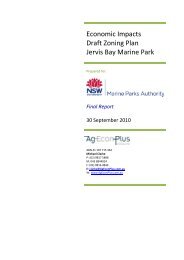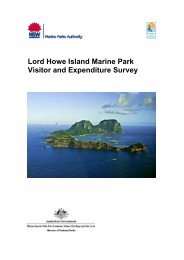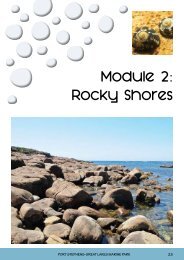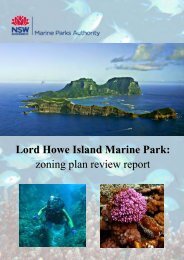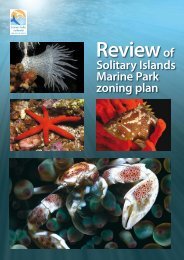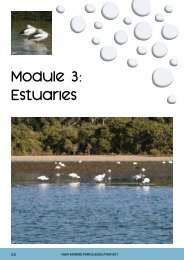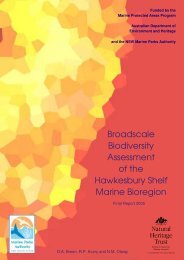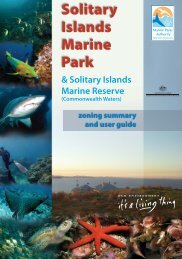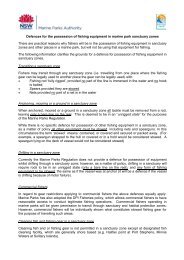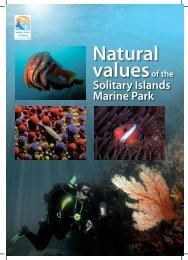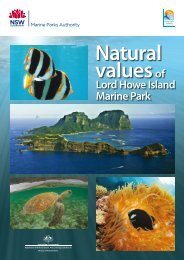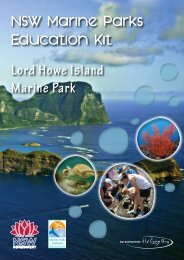Research Project Summaries 2002-2009 - Marine Parks Authority ...
Research Project Summaries 2002-2009 - Marine Parks Authority ...
Research Project Summaries 2002-2009 - Marine Parks Authority ...
Create successful ePaper yourself
Turn your PDF publications into a flip-book with our unique Google optimized e-Paper software.
2. Biodiversity and ecological processesThe primary criteria for establishing marine parks in Australia are that they contain acomprehensive, adequate and representative selection of marine biodiversity.Comprehensiveness is the extent of the full range of ecosystems and habitats in andacross all bioregions; adequacy is the degree to which the size, boundaries andlocation of marine parks are adequate to maintain biodiversity and ecological patternsand processes, particularly in relation to managing impact on such patterns andprocesses; and representativeness is a reflection of the range of biological diversity ofcommunities within ecosystems and habitats (ANZECC TFMPA 1998).To ensure zoning arrangements meet the above objectives most effectively, it isimportant to include biodiversity and ecological information when planning. In manyregions, data on biotic composition or species distribution come from surveys atindividual sites, examining communities or life-history of abundant and ofteneconomically important species. However, detailed spatial information on thedistribution of a wide range of species is generally limited. There is increasing evidencethat habitats may act as effective ‘surrogates’ for species diversity in the planningprocess, provided they are appropriately validated (Ward et al 1999), and allrepresentative habitats are included (Roff et al 2003). Therefore, mapping the extent,structure and distribution of seabed habitats can be a cost-effective method ofbiodiversity assessment.However, since biological diversity can be defined at multiple levels, habitats must bemapped and classified at levels within a hierarchical framework. In the context ofseabed mapping, the upper levels in the hierarchy are specifically delineated throughremote sensing and associated ground truthing (visual observations of the seabed toidentify or validate features mapped remotely, e.g. using swath acoustic sonar), andare commonly based on geophysical features (Zacharias et al 1998, Greene et al 1999,Roff and Taylor 2000, Bax and Williams 2001) or a combination of biological andphysical features (Allee et al 2000). Recent advances in swath acoustic methods haveallowed increased resolution and spatial coverage of the seabed and examination ofthe biophysical extent and structure of various habitats (Kostylev et al 2001, Brown etal <strong>2002</strong>, Beaman et al 2005). These advancements have led a number of seabedmapping programs in NSW providing important information on the planning andassessment of marine park zones.The zoning plans in Solitary Islands and Jervis Bay marine parks used a habitatclassification system as a surrogate for biodiversity, and this is likely to remain a keyplanning tool in NSW marine parks. However, its effectiveness will depend to someextent on how well it represents patterns of biodiversity (Gladstone <strong>2002</strong>, Smith 2005,Winberg et al 2007a). The habitat classification system primarily uses depth todifferentiate habitat types; depth has been demonstrated to strongly influenceassemblages and species in different taxonomic groups including fishes (Connell andLincoln-Smith 1999, Williams and Bax 2001) and benthic organisms (Garrabou et al<strong>2002</strong>). While depth and habitat are often closely linked, if other factors were shown tohave a strong influence, a system based solely on depth may not be an ideal planningtool. Reefs can also be classified into different ‘reef types’ based on broadgeomorphologic categories, including whether it is attached to emergent rock (e.g.headlands, islands, islets, rocks) or is fully submerged at all tides.An important component of a marine ecosystem’s biological diversity and ecologicalfunction is reef-associated fishes (Shears and Babcock <strong>2002</strong>). These fishes also havesocial, cultural and economic value, therefore are relevant for marine park planning intheir own right (Gladstone 2007). Combining information on spatial patterns ofSolitary Island and Jervis Bay <strong>Marine</strong> <strong>Parks</strong> <strong>Research</strong> <strong>Project</strong>s <strong>Summaries</strong> <strong>2002</strong>–<strong>2009</strong> 3



